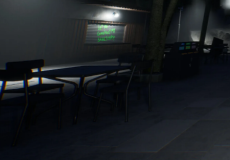
Another Girl In The Wall
Advertisement
Another Girl In The Wall is a short narrative-driven horror game that focuses on isolation, perception, and hidden memory. The story takes place within a small apartment, where the player slowly uncovers details about a girl who appears to be trapped or connected to the walls. The game presents a confined setting that reveals information through exploration and subtle environmental clues. Progression depends on observation, interaction, and interpreting fragmented dialogue rather than completing complex tasks or puzzles.
Advertisement
Similiar games
Another Girl In The Wall is a short narrative-driven horror game that focuses on isolation, perception, and hidden memory. The story takes place within a small apartment, where the player slowly uncovers details about a girl who appears to be trapped or connected to the walls. The game presents a confined setting that reveals information through exploration and subtle environmental clues. Progression depends on observation, interaction, and interpreting fragmented dialogue rather than completing complex tasks or puzzles.
Story and Gameplay Structure
The gameplay in Another Girl In The Wall follows a linear format that gradually unfolds through scripted events. The player moves through different rooms, inspecting objects and reacting to new discoveries as the environment changes. The focus remains on tension built through sound, light, and timing rather than direct confrontation. The main gameplay elements include:
- Exploring small areas to uncover new narrative fragments
- Interacting with objects that trigger changes or memories
- Observing sound cues that indicate hidden movement or events
- Following the story through environmental transitions
This structure allows the narrative to develop naturally while maintaining a consistent rhythm of discovery and unease.
Environment and Presentation
The environment of Another Girl In The Wall is intentionally limited in scale, emphasizing confined spaces that reinforce the story’s focus. The layout of the apartment changes slightly with each phase, altering player orientation and perspective. Visual design relies on muted colors and subtle shifts in texture to signal transformation. Audio is central to the experience, with environmental noises acting as both clues and narrative devices. Every creak, knock, or whisper contributes to the understanding of what exists beyond the walls.
Narrative Themes and Progression
The story addresses themes of disappearance, memory, and the boundary between the visible and the hidden. The player learns fragments about the girl and her connection to the protagonist through indirect storytelling. Events occur without direct explanation, leaving interpretation open to the player. Each stage builds toward a final revelation that redefines earlier events, encouraging a second playthrough for full understanding. The simplicity of the gameplay allows the story’s psychological elements to remain central throughout the experience.
Discuss Another Girl In The Wall


















